
Allerton is a village in Sidell Township, Vermilion County, Illinois, United States. A small portion of the village extends into Champaign County. The population was 262 at the 2020 census.

Bondville is a village in Champaign County, Illinois, United States. The population was 388 at the 2020 census.
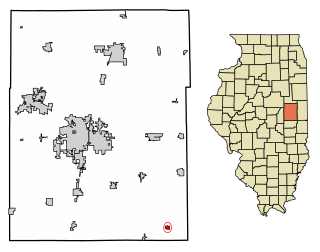
Broadlands is a village in Champaign County, Illinois, along the East Branch of the Embarras River. The population was 316 at the 2020 census. Originally owned by the Sullivant family, Broadlands was, at over 70,000 acres (280 km2), one of the world's largest farms in the late 1860s. Broadlands was sold to John T. Alexander in 1866, and it was broken up upon his death in 1876 to pay his creditors.

Foosland is a village in Brown Township, Champaign County, Illinois, United States. The population was 75 at the 2020 census. The village is named after William Foos, who owned 3,500 acres in the area in the 1840s.

Gifford is a village in Champaign County, Illinois, United States. The population was 911 at the 2020 Census.

Ivesdale is a village in Champaign County, Illinois, United States; a very small portion of the village extends into Piatt County, Illinois. The population was 265 at the 2020 census.

Longview is a village in Champaign County, Illinois, United States. The population was 112 at the 2020 census.

Ludlow is a village in Champaign County, Illinois, United States. The population was 308 at the 2020 census.

Mahomet is a village in Champaign County, Illinois, United States, along the Sangamon River. The population was 9,434 at the 2020 census. Mahomet is located approximately 10 miles (16 km) northwest of Champaign at the junction of Interstate 74 and Illinois Route 47.
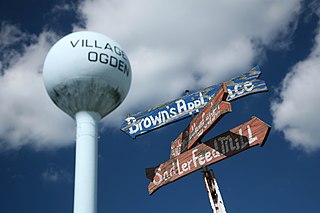
Ogden is a village in Champaign County, Illinois, United States. At the time of the 2020 census, the population was 729.
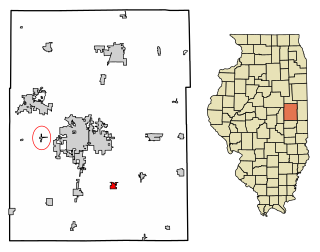
Philo is a village about nine miles south of Urbana in Champaign County, Illinois, United States. The population was 1,392 at the 2020 census.

Royal is a village in Champaign County, Illinois, United States. The population was 293 at the 2020 census.

Savoy is a village in Champaign County, Illinois, United States. The population was 8,857 at the 2020 census. It is part of the Champaign–Urbana metropolitan area.
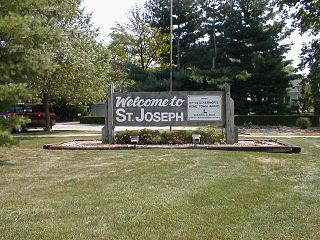
The Village of St. Joseph was founded on April 28, 1881, and is located in St. Joseph Township, Champaign County, Illinois, United States. The population was 3,810 at the 2020 census, down from 3,967 at the 2010 census.

Tolono is a village in Tolono Township, Champaign County, Illinois, United States. The population was 3,604 at the 2020 census. Its name was fabricated by J.B. Calhoun, land commission of the Illinois Central Railroad, who wrote about it simply: "[I] placed the vowel o three times, thus o-o-o, and filling in with the consonants t-l-n."
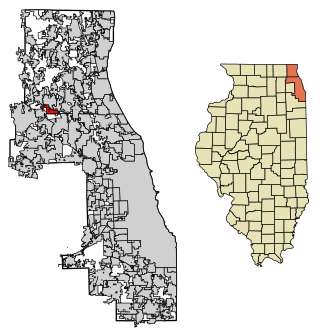
Deer Park is a village in Lake and Cook Counties, Illinois. Per the 2020 census, the population was 3,681. The village is one of the few left in the Chicago area that enjoy a green belt which is bordered by two large natural areas providing outdoor recreation and open space. The village is home to popular shopping and dining destinations: Deer Park Town Center and the Town Center Promenade. The town is also home to the Vehe Farm, an Illinois Centennial Farm.
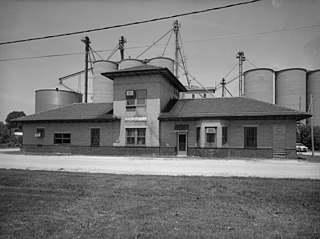
Minooka is a village in Grundy, Kendall, and Will counties, Illinois, United States. The population was 12,758 at the 2020 census, up from 10,924 at the 2010 census. The village is part of the Chicago metropolitan area.

Clifton is a village in Chebanse Township, Iroquois County, Illinois, United States. The population was 1,468 at the 2010 census, up from 1,317 at the 2000 census.

Elizabeth is a village in Jo Daviess County, Illinois, United States. The population was 761 at the 2010 census.

Coffeen is a small city in Montgomery County, Illinois, United States. The population was 647 at the 2020 census.

























